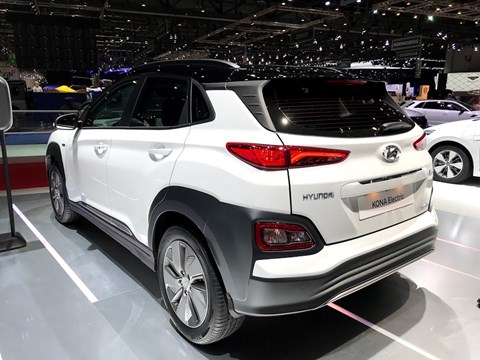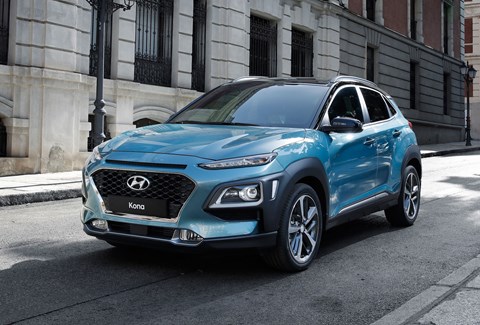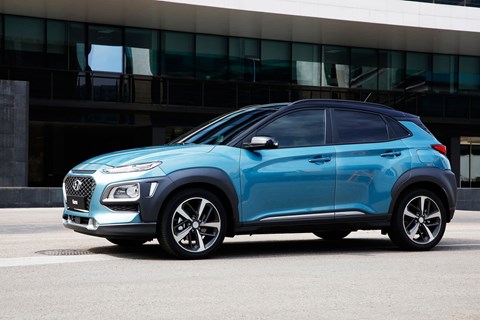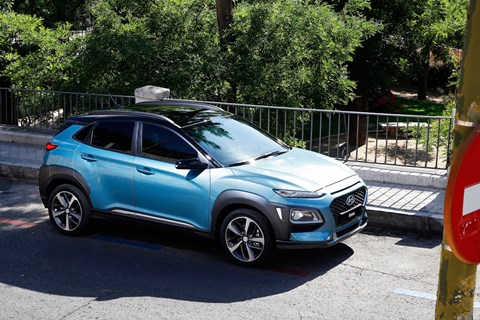► Hyundai Kona Electric priced from £25k
► That’s after the plug-in grant lops off £5k
► Boasts impressive 292-mile electric range
Hyundai’s new Kona Electric crossover will cost £25,000 after the government EV grant is taken into account – bringing long range, popular SUV bodystyle and affordable pricing to bear in the mushrooming electric car scene. UK sales start on 2 August 2018.
Hyundai has timed it right – there isn’t a keener time than now to develop and show off an electric crossover; Jaguar is doing it with the I-Pace, Audi is building one off of its e-tron quattro concept and a fully-electric Volvo XC40 is due in 2020.
Anyway – back to the Kona EV. Two power options will be available; one with a 39.2kWh battery and another with a 64kWh power source. The former is good for 186 miles, while the latter is rated at a stretchier 292 miles and a 0-62mph time of 7.6 seconds. Both have 291lb ft and are capable of 103mph.

The Kona EV comes with loads of kit and can be specced with more; wireless charging, an audio system from Krell, adaptive cruise and head-up display.
Charging-wise, the Kona EV on a 100kW DC charger takes 54 minutes to gain 80% of charge. Using the on-board 7.2kW charger, it’s estimated to take 9h 40m for the long-rage battery version and 6h10m for the short-range battery pack.
Prices and specs aren’t known yet for the Kona EV, although we understand that it will ‘significantly undercut its closest rivals’.
In the meantime, check out all you need to know about the Kona crossover.
Don’t miss our guide to the best electric cars of 2018
Read on to read all the news, specs, prices and more info on the new Hyundai Kona range from its 2017 launch

After countless teaser images, and a drip feed of information from Korea, Hyundai’s fourth SUV in its European lineup – the Kona – has finally broken cover. And you know what – the all-new SUV shows that Hyundai is really taking its design language seriously these days.
Added a fourth family-sized SUV to its line-up shows most potently how the march of the small family SUV continues unabated. Beneath the ‘active lifestyle’ bluster of the company’s description beats the heart of what promises to be a very interesting rival to the Nissan Juke, Renault Captur, Vauxhall Mokka X, Crossland X or its sister car, the Peugeot 2008.
The Hyundai Kona: design
You can’t say Hyundai’s not trying, thanks to its dramatic profile and sophisticated side sculpting, but the cascading grille is a little too familiar, even though we like the ‘composite lamps’ which flank it. The Kona has a floating roof that everyone else now seems to have, ripe for two-tone personalisation.
The slim daytime running lights (DRLs) are reminiscent of the squinting affairs you’ll find on a Jeep Cherokee or Citroen C3 Aircross, but neatly house turn signals and are positioned in a stack, separate to the LED headlights.

At the rear, you get a set of de rigeur LED rear lamps, with the slim, Alfa-like tail lights are supplemented by separate clusters housing the brake lights, indicators and reversing lamps. If it worked for the Vauxhall Frontera, Hyundai will be just fine.
It’s de-cluttered inside, too. With a split dashboard that leaves the display monitor appears to float above it. It’s a set-up that debuted in the i10 and i30, and which simplifies the way the heating, ventilation and air-conditioning controls work. Hyundai has been working hard to perfect the ergonomic experience of its mainstream cars.
Lead designer Luc Donckerwolke says that these themes will remain unique to the Kona. ‘We will not make a family of clones,’ he vows.
Never mind that, what’s the new Hyundai Kona like underneath?
The Kona sits on the company’s all-new B-SUV compact platform, complete with jacked-up ride height and elevated H-points that buyers in this sector demand. Cabin space is enhanced by a clever split floor, minimising the intrusion from a transmission tunnel.
A compact independent rear suspension set-up means there’s a lower floor, and a more flexible seating position, front and rear. This is particularly beneficial when the Kona is fitted with optional four-wheel drive – the propshaft driving the rear wheels and exhaust system don’t intrude into the passenger compartment at all without the need for that central tunnel.
Are there any clever engines?
At launch the engine line-up looks pretty vanilla. So, that’s a no, then? It is on trend, though, by offering a trio of small displacement turbo petrols, to complement the one diesel for those not yet ready to make the step away from DERV.

The petrols start with the 1.0 T-GDI turbocharged three-pot. It’s hooked up to a six-speed manual ‘box, and produces 118bhp for a 0-62mph time of 12 seconds and a maximum speed of 119mph. Next up (in terms of power, anyway), is the 2.0-litre petrol, not coming to the UK. It’s an Atkinson-cycle power unit that promises great fuel consumption. With 147bhp and a six-speed auto ‘box, it’s good for 0-62mph in 10 seconds and a maximum speed of 121mph.
Top dog of the petrol pack (at least until the 250bhp Kona-N is launched) is the Gamma 1.6 T-GDI, with 175bhp, a 0-60mph time of 7.7 seconds and a maximum speed of 130mph. There aren’t any fuel consumption figures to talk about yet, which is probably why the forthcoming 1.6 diesel isn’t being talked about at the Korean launch. Besides, no one in Asia buys diesel-powered cars.
Will it handle?
It’s too early to say – at least until we drive it later in the week – but the signs are good. It had been engineered for maximum body rigidity, and has a lightweight body fashioned from various grades of high-tensile steel.
The suspension set-up is comprised of MacPherson struts at the front, with two different independent layouts at the rear, depending if it’s four-wheel drive or not. It’s been tuned specifically for European roads by Hyundai’s German-based R&D centre.
Hyundai offers three driving modes (Sports, Normal and Eco), optimising torque split and gearchanges to get the best out of it if you want to crack on. Wind it back to Eco mode for lazier throttle mapping and gearing to get the best fuel consumption.

Expect decent steering and brakes, competent body control, and handling that’s biased for comfort. You can be sure its sister, the Kia Stonic, to be the sportier of the pair.
Is it safe?
You bet. You get all the current tech you’d expect, so there’s a type of Autonomous Emergency Braking (called Forward Collision-Avoidance Assist in Hyundai’s universe), Lane Keeping Assist (LKA), High Beam Assist (HBA), and Driver Attention Warning (DAW).
It’ll also warn you of vehicles in your blind spot, there’s cross-traffic alert, and you can fit it with a head-up display to complement its 5.0-, 7.0- or 8.0-inch infotainment screen. Finally, you can cut down interior clutter with wireless smartphone charging – although that’s an option (just as well if your mobile doesn’t support it).
What’s next?
Kona is a district of Hawaii and Hyundai claims the name ‘reflects the island’s energetic image and unique lifestyle.’ It continues the firm’s history of naming its SUVs after geographical locations around the world.
Euisun Chung, Vice Chairman of Hyundai Motor Company says, ‘With the Kona, we have created a stylish and highly functional compact SUV, perfectly suited to the needs of customers who pursue challenging, action-filled lifestyles.’
What we say is that it ensures that Hyundai remains on target to overtake Toyota to become the largest Asian car brand in Europe, with a line-up of 30 new models to be launched by 2021.
It goes on sale in the UK in the autumn of 2017, with prices to be released nearer the time.
Hyundai reviews by CAR magazine